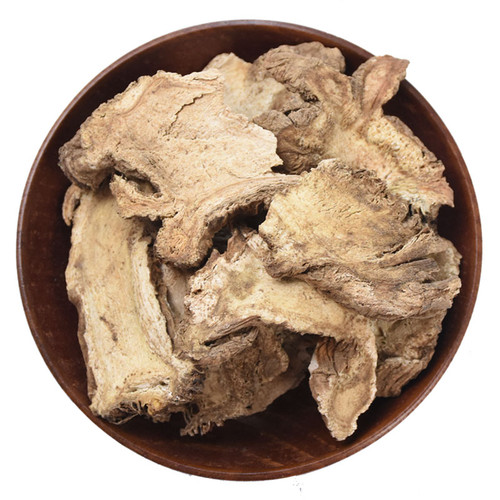Product Overview
Parts used: Dried root
TCM category: Herbs that dispel Wind and Dampness
TCM nature: Warm
TCM taste(s): Bitter Pungent
Meridian affinity: Bladder Kidney
Scientific name: Angelica pubescens
Other names: Angelica Du Huo
Use of pubescent angelica roots (Du Huo) in TCM
Please note that you should never self-prescribe TCM ingredients. A TCM ingredient is almost never eaten on its own but as part of a formula containing several ingredients that act together. Please consult a professional TCM practitionner, they will be best able to guide you.
Preparation: Remove impurities, wash, slice, dry at low temperatures.
Dosage: 3 - 9 grams
Main actions according to TCM*: Disperses Wind, Cold, Dampness. Relieves pain. Relieves Lesser Yang (Shao Yang) headache.
Primary conditions or symptoms for which pubescent angelica roots may be prescribed by TCM doctors*: Back pain Knee pain Headache Rheumatism Common cold Toothache
Contraindications*: Do not use when there is Yin Deficiency with Heat signs.
Common TCM formulas in which pubescent angelica roots are used*:
For Wind-Damp obstruction or rheumatic aches and pains combine pubescent angelica roots with dong quai (Dang Gui), mistletoe (Hu Ji Sheng) and clematis roots (Wei Ling Xian).
For stiffness and aching pain in the lower back with difficulty bending at the waist and/or knee pains combine pubescent angelica roots with mistletoe (Hu Ji Sheng) and achyranthes roots (Niu Xi).
Key TCM concepts behind pubescent angelica roots (Du Huo)'s properties
In Traditional Chinese Medicine (TCM), pubescent angelica roots are plants that belong to the 'Herbs that dispel Wind and Dampness' category. These herbs typically help treat what's called 'bi pain' (i.e. painful obstruction) in TCM. This roughly corresponds to arthritic and rheumatic conditions with pain, stiffness and numbness of the bones, joints and muscles.
Furthermore pubescent angelica roots are plants that are Warm in nature. This means that pubescent angelica roots tend to help people who have too much "cold" in their body, although with less effect than a plant that would be Hot in nature. Balance between Yin and Yang is a key health concept in TCM. Those who have too much cold in their body are said to either have a Yin excess (because Yin is Cold in nature) or a Yang deficiency (Yang is Hot in Nature). Depending on your condition pubescent angelica roots can help restore a harmonious balance between Yin and Yang.
Pubescent angelica roots also taste Bitter and Pungent. The so-called "five elements" theory in Chinese Medicine states that the taste of TCM ingredients is a key determinant of their action in the body. Bitter ingredients like pubescent angelica roots tend to have a cleansing action on the body by clearing heat, drying dampness and promoting elimination via urination or bowel movements. On the other hand Pungent ingredients tend to promote the circulations of Qi and body fluids. That's why for instance someone tends to sweat a lot when they eat spicy/pungent food.
The tastes of ingredients in TCM also determine what organs and meridians they target. As such pubescent angelica roots are thought to target the Bladder and the Kidney. In TCM the impure water collected by the Kidneys that cannot be used by the body is sent to the Bladder for storage and excretion as urine. The Kidneys do not only regulate the urinary system but also play a key role in the reproductive system and the growth and aging process of the body.






